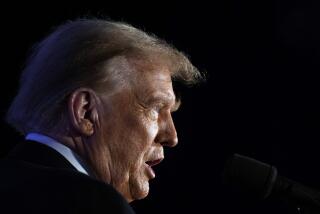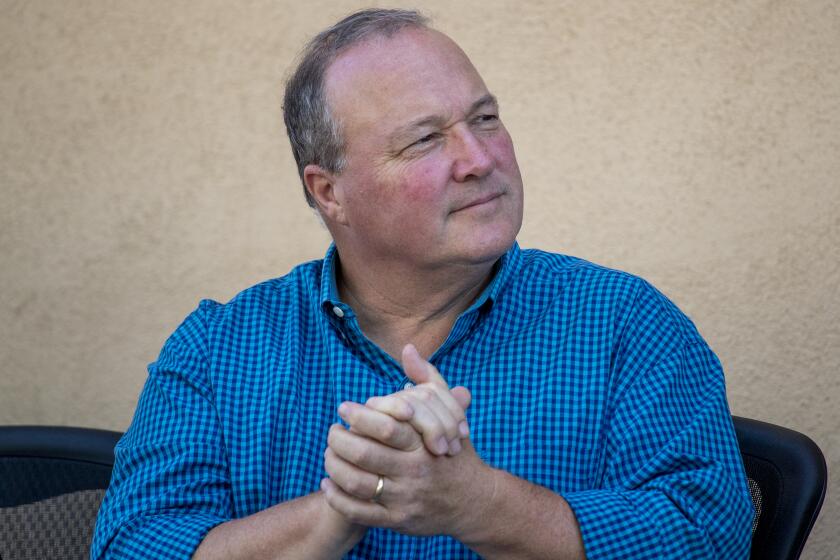Iraq War Weighs Heavy on New Mexico’s Voters
Yolanda Garcia has never been an undecided voter before. But this election season, the 46-year-old paralegal, like many in her home state of New Mexico, is torn.
The political battle lines that divide the state even show up in the law firm where Garcia works. During lunchtime debates, the die-hard Democratic senior partner argues with staunchly Republican secretaries. Although she’s unsure who to vote for, Garcia has a nephew deployed in Iraq and other relatives in the military, and she wants the troops home.
But the onetime Gore supporter is still not sold on Sen. John F. Kerry as commander in chief.
“I’m not sure Kerry could defend us,” Garcia said. “He keeps saying ... he would only go to war when absolutely necessary. Is absolutely necessary going to be when a lot of people have already died?”
In scores of interviews with New Mexicans, the war in Iraq -- and its cost at home -- was the issue weighing most heavily on people’s minds. Democrats here wonder when the conflict might end, and worry that its costs are spiraling out of control. Republicans tend to trust the president’s leadership and think it’s safer to stick with a known quantity in the White House.
This election season, what matters to New Mexicans matters nationwide. Other, larger swing states like Pennsylvania and Florida might get more media attention, but Bush and Kerry are actively courting New Mexicans to capture the state’s five electoral votes. Between the two of them, the candidates have visited the state at least half a dozen times this year.
At first glance, the edge would seem to go to the Democrats, who make up more than half the state’s registered voters, compared with 32% who are registered Republicans. But it is by no means a Democratic stronghold -- Al Gore won the state by just 366 votes in 2000.
And Kerry’s initial lead here has been slipping. Poll numbers alternately put Bush and then Kerry ahead. Which candidate is on top in New Mexico simply depends on where you’re standing -- the left-leaning north, conservative southeast or swing zones surrounding Albuquerque and Las Cruces.
“It’s by no means over in New Mexico.... We’ve seen these swings before, we may see them again,” said Brian Sanderoff, president of Research & Polling Inc., New Mexico’s largest independent pollster.
For every “W ‘04” sticker plastered on dusty pickup bumpers around Albuquerque, the state’s largest city, there seems to be a matching one that says “Outsource Bush.”
New Mexico is home to an intersection of cultures whose disparate political leanings constitute an unlikely political bellwether. Since 1912, the state has rarely backed a losing presidential candidate and has hewed closely to the nation’s popular vote, as it did in 2000 when Gore edged out Bush.
While the state’s voting habits often mirror the nation, New Mexicans themselves do not. The state’s population is 42.1% Hispanic, and many of those residents trace their New Mexican roots back generations. They live largely in the north-central part of the state: in Santa Fe and Taos, communities nestled against the Sangre de Cristo Mountains, and other smaller towns. Many Hispanics prefer that moniker to Latino, a nod to their Spanish and American -- rather than Latin American -- ancestry.
“Hispanics are more integrated into the state’s economic, political and social structure here than in any other state,” said F. Chris Garcia, a professor of Hispanic politics, public opinion and voting behavior at the University of New Mexico.
But in a state dotted with Spanish colonial plazas and 18th century Catholic churches, there are also pockets of recently arrived Latin American immigrants. These relative newcomers live mostly in the southern part of the state, closer to the Mexican border, and many are socially conservative. This boosts Bush’s hopes of claiming what is traditionally a Democratic demographic. But the potential political impact of the mostly Democratic Hispanic voting bloc is diluted by low voting rates.
Further balancing the state’s vote is “Little Texas,” the eastern, conservative portion of the state that is pure Bush country.
Folks there admire the president’s “common-sense moral family values,” said Dennis J. Roch, 30, a math and English teacher at Texico High School in Texico, on the Texas border.
“Kerry’s stances are so inconsistent and folks don’t trust that,” said Roch, who spoke at a Laura Bush event in nearby Clovis on Wednesday. “I’m from eastern New Mexico, where people are cowboys. They need to know where you stand.”
This rural, agricultural region of the state is one that has largely missed out on the job growth that New Mexico’s metropolitan areas have seen the last few years. Unemployment in the state is a respectable 5.5%, below the 5.6% national average. Nearly 50,000 jobs have been created since 2001, the year Bush took office.
But these multiplying jobs, many in construction, healthcare expansion and Indian casinos, are often low-wage or part-time. Poverty permeates reservations and New Mexico’s rural high plains and deserts.
“The benefit of those jobs does not extend across the entire state,” said Larry Waldman, senior economist at the Bureau of Business and Economic Research at the University of New Mexico.
New Mexico is one of the poorest states in the nation, ranked by the U.S. Census as 49th in percentage of residents living in poverty and 47th in per capita income. Nearly one in four residents lacks health insurance -- one of the highest rates in the country.
Jane Yellowhorse, a 60-year-old Navajo, is one of them. She will mostly likely have to shell out $4,000 of her own money for an eye operation that was first approved for payment by Indian Health Services.
Then the organization told her it couldn’t foot the bill. Now Yellowhorse and her husband, Dennis, who both supported Bush in 2000, are having serious second thoughts about the president.
“I’m really disappointed because of the way the economy is and why we spent $300 billion and up to support this war,” said Jane, of Albuquerque, who sells Native American jewelry and art with her husband. “It’s not the Navajo way. The money could be used for much better things.”
And Dennis has seen rising gas prices take a bite out of their business, which requires them to drive thousands of miles across the Southwest selling their wares.
“You have to work twice as hard, three times as hard to get back to where you were,” said Dennis, 50, his cowboy hat, sunglasses and beard nearly obscuring his face. “If people vote their pocketbooks this election, [Republicans are] in trouble.”
The Yellowhorses are part of the sizable Native American population that makes up nearly 9% of the state’s residents. Members of more than a dozen tribes cluster in the northwest corner of the state and along the Rio Grande Valley in its central section. Traditionally, they have supported Democrats even more solidly than the Hispanics have.
One unpredictable factor in a state with a strong environmental movement is Ralph Nader. After legal wrangling, the state Supreme Court ruled this week that Nader could appear on the state’s ballot as an independent. Nader won 4% of the New Mexico vote in 2000, when he ran as a Green Party candidate.
Paralegal Garcia is eager to see Bush and Kerry duke it out tonight.
“I’m looking forward to listening to the debates, and I don’t even like debates,” she said. “After the Gore race, I know it matters.”
More to Read
Get the L.A. Times Politics newsletter
Deeply reported insights into legislation, politics and policy from Sacramento, Washington and beyond. In your inbox three times per week.
You may occasionally receive promotional content from the Los Angeles Times.










